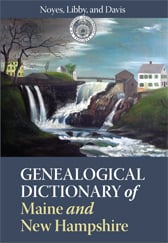 For more than seventy years the Genealogical Dictionary of Maine and New Hampshire – compiled by Charles Thornton Libby, Walter Goodwin Davis, and Sybil Noyes, and published between 1928 and 1938 – has been the first recourse for those looking to trace their seventeenth-century northern New England ancestry. It is one of a handful of titles in the genealogical field that has never been out of print for very long.
For more than seventy years the Genealogical Dictionary of Maine and New Hampshire – compiled by Charles Thornton Libby, Walter Goodwin Davis, and Sybil Noyes, and published between 1928 and 1938 – has been the first recourse for those looking to trace their seventeenth-century northern New England ancestry. It is one of a handful of titles in the genealogical field that has never been out of print for very long.
The compilers’ aim was this: to document the lives and families of all the area’s inhabitants who settled there by 1699, with three generations of their descendants. Its nearly eight hundred pages of incredibly dense (but never uninteresting) text are brimming not only with the basic genealogical facts of our ancestors’ lives, but also the records that illustrate, sometimes graphically, their human side as well. For example, about Philip Chesley of Oyster River, New Hampshire, we are told that “his and his 2d wife’s share of existing records would fill a ‘movie,’ an alternating current of honor[able] and impuls[ive] activ[ities].” Of John Hart, shipwright, of Portsmouth, and his wife Ann, we learn that “Geo. Jones fought with him . . . and gave Ann a black eye, 1662.” And we learn the following of Hubertus Mattoon: “devoted to women, he m[arried] at least three. . . . In June 1673 he m[arried] one equally devoted to men, Sarah (Pearce) Jones, whose husb[and] was living and undivorced. Mattoon divorced her in 1682, when she confessed misconduct, accusing him of the same and of desertion above 7 y[ea]rs.” Clearly, our ancestors’ lives were not dull.
The Dictionary contains hundreds of thousands of statements of fact and of judgment. Its greatness derives from its comprehensiveness. It represents one of the most thorough and exhaustive studies of an entire population ever undertaken. Rather than rely on earlier, uncritical secondary sources, the compilers dispassionately sifted and collated a wealth of primary sources to document both the great and the obscure. By looking at the whole picture and not just individual families, they were able to see patterns, make connections, and reach conclusions that had eluded their predecessors. This democratic approach to genealogy was a hallmark of the early twentieth-century disciples of Donald Lines Jacobus, who shunned the biases of mere ancestor-hunting in favor of a more rigorous methodology, and that had applications to the studies of populations and of history itself. The genealogist Danny D. Smith has written that “the Dictionary is a pioneer model population study, invaluable to demography, sociology, and the related social sciences.”
There is no doubt that the Dictionary is a triumph of genealogical scholarship. For many of the subjects of the book’s sketches, it remains today the only source in which their names appear in print. With this new printing, the Genealogical Dictionary of Maine and New Hampshire is once again accessible to a new generation of genealogists.
Adapted from the foreword to the new NEHGS edition of Libby, Davis, and Noyes’ Genealogical Dictionary of Maine and New Hampshire.
Share this:
About David Dearborn
Originally from Andover, Massachusetts, David Dearborn joined the NEHGS staff in 1976 and has been interested in genealogy since the age of eighteen. David graduated with a B.A. in History in 1971 from the University of Massachusetts at Boston. He received his M.A. in History in 1974 from Northeastern University. He received his M.S. in Library Science in 1982 from Simmons College. David’s genealogical interests include the Dearborn Family (descendants of Godfrey, who arrived in New Hampshire by 1638); families of Essex County, Massachusetts and of Maine, New Hampshire, and Vermont; New York City and urban genealogy; twentieth-century genealogy; eighteenth and nineteenth-century English and Scottish genealogy; Italian genealogy; Westward migration.View all posts by David Dearborn →